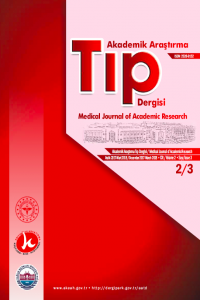Abdominal Aorta Anatomik Varyasyonları
ÇKBT, varyant anatomi, abdominal aorta
Anatomic Variations of Abdominal Aorta
___
- 1. Prokop M. Multislice CT angiography. Eur J Radiol 2000;36:86-96.
- 2. Duddalwar VA. Multislice CT angiography in vascular imaging and intervention. Br J Radiol 2004;77:S27-38.
- 3. Catalano OA, Singh AH, Uppot RN, et al. Vascular and biliary variants in the liver: implications for liver surgery. Radiographics 2008;28:359-78.
- 4. Winston CB, Lee NA, Jarnagin WR, et al. CT angiography for delineation of celiac axis and superior mesenteric artery variants in patients undergoing hepatobiliary and pancreatic surgery. AJR Am J Roentgenol 2007;189:W13-9.
- 5. Williams PL, Warwick R, Dyson M, et al: Gray's Anatomy, 37th Ed, Edinburgh, Churchill Livingstone; 1989.
- 6. Moore M.K. Çeviri Editörleri: Yıldırım M., Okar İ., Dalçık H.: İnsan Embriyolojisi Klinik Yönleri ile,1. baskı, İstanbul; 2002: 380-394.
- 7. Chen H, Yano R, Emura S, et al. Anatomic Variation of The Celiac Trunk with Special Reference to Hepatic Artery Patterns. Ann Anat. 2009; 191.399–407.
- 8. Vandamme JPJ, Bonte J. The Branches of The Celiac Trunk. Acta anat. 1985; 122:110–4.
- 9. Göktay AY, Seçil M. Çölyak Trunkus ve Hepatik Arterlerin Normal Dallanma Varyasyonları: Anjiografik Bulgular. Tanısal ve Girişimsel Radyoloji. 2001; 7: 226–31.
- 10. Yang Y, Jiang N, Lu MQ, et al. Anatomical Variation of The Donor Hepatic Arteries:Analysis of 843 Cases. Nan Fang Yi Ke Da Xue Xue Bao. 2007; 27:1164-6.
- 11. Uzun A, Ulcay T, Kosif R, Baş O, Emirzeoğlu M. Anomalies of number and orıgın of the renal artery: case report and review of the literature. J. Urol. 2002;28:452-7.
- 12. Özkan U, Oğuzkurt L, Tercan F, Kızılkılıç O, Koç Z, Koca N. Renal artery origins and variations: Angiographic Evaluation of 855 Consecutive Patients. Diagn Interv Radiol. 2006;12:183-18.
- 13. Satyapal K.S,Haffejee A.A,Singh B, Ramsaroop L, Robbs J.V,Kalidden I.M. Additional renal arteries. Surg Radiol Anat. 2001;23:33-8.
- 14. Benedetti E, Troppmann C, Gillingham K, David E.R, Sutherland, William D, Payne, Dunn L.D, Matas J.A, Najarian S.J, Gruessner G.W.R. Short- and Long-Term Outcomes Kidney transplants with multiple renal arteries. Ann. of Surgery. 1995; 221:406-14.
- 15. Cuxart M, Picazo M, Matas M, Canalias J, Nadal C, Falcó J. Arterial hypertension and stenosis of the accessory renal artery. Nefrologia 2007;27:509-10. 16. Ferrari R, De Cecco CN, Lafrate F, et al. Anatomical variations of coeliac trunk and the mesenteric arteries evaluated with 64-row CT angiography: Radiol Med 2007;112:988-98. 17. Song SY, Chung JW, Yin YH, et al. Celiac axis and common hepatic artery variations in 5002 patients: Systemic Analysis with Spiral CT and DSA. Radiology 2010;255:278-88.
- 18. Sampaio F.J.B, Passos M. Renal arteries: anatomic study for surgical and radological practise. Surg radiol anat. 1992;14:113-7.
- 19. Bordei P,Şapte E, Iliescu D, Double Renal arteries originating from the aorta. Surg Radiol Anat. 2004;26:474–9.
- ISSN: 2528-9152
- Başlangıç: 2016
- Yayıncı: Keçiören Eğitim ve Araştırma Hastanesi
Primer Üretral Malign Melanom: Olgu Sunumu
Selçuk SARIKAYA, Erman DAMAR, Rıdvan ÖZBEK, İsmail SELVİ, Mehmet ÇİFTÇİ, Gülçin Güler ŞİMŞEK, Ömer Faruk BOZKURT, Öztuğ ADSAN
Nonmetastik Testis Tümörleri Patoloji Sonuçlarımız: Klinik Tecrübemiz Ve Literatür İncelemesi
Selçuk SARIKAYA, Rıdvan ÖZBEK, Görkem GÜVENİR, Çağrı ŞENOCAK, Gülçin GÜLER ŞİMŞEK, Ömer Faruk BOZKURT
Bilateral Aksesuar Submandibular Gland
Hatice KAPLANOĞLU, Alper DİLLİ
A.safa TARĞAL, Bahtiyar HABERAL, Hakan ŞEŞEN, İsmail DEMİRKALE, Ahmet ATEŞ, Murat ALTAY
Abdominal Aorta Anatomik Varyasyonları
Özlem GÜNGÖR, Ömer Faruk GÜLER, Cansu ÖZTÜRK, Selma UYSAL RAMADAN
